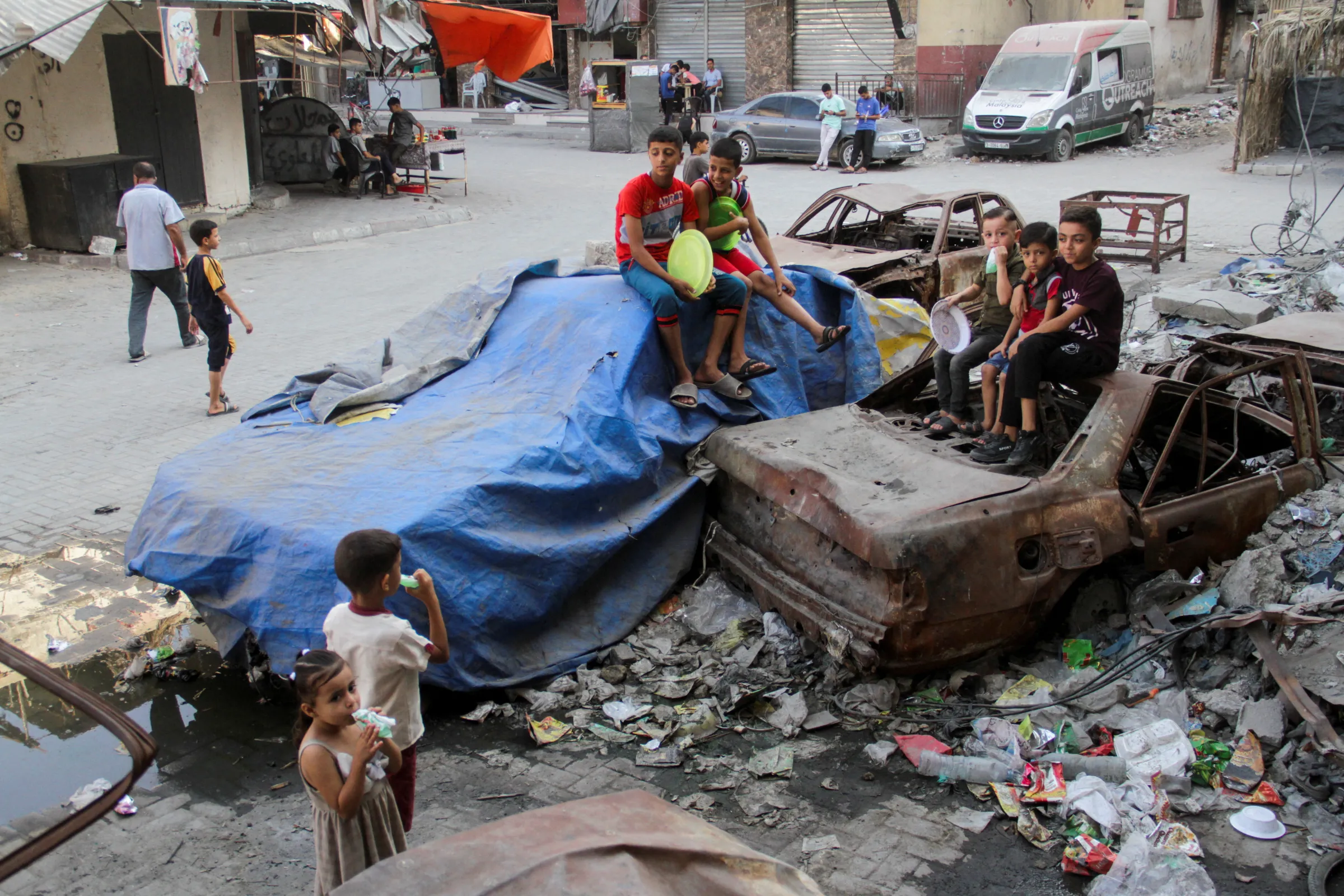How is conflict in the Middle East affecting the climate?

Children sit on damaged cars as conflict between Israel and Hamas continues, in the northern Gaza Strip August 14, 2024. REUTERS/Mahmoud Issa
As conflicts spread, military forces must do more to measure their carbon footprints and find sustainable ways to cut emissions.
Benjamin Neimark is a senior lecturer at Queen Mary University of London and Frederick Otu-Larbi is a lecturer at the University of Energy and Natural Resources, Ghana.
Over the past months and years, we’ve seen all too clearly what armies and munitions can do to humans and the environment. Less visible, and less well understood, are the devastating effects of war on our climate.
The world’s military forces are some of the largest consumers of hydrocarbons in the world. They also have some of the largest greenhouse gas footprints, equal to those of medium-sized countries.
But little is known about their overall contribution to climate change.
Countries have different reporting responsibilities under the United Nations Framework Convention on Climate Change (UNFCCC), and since the Paris agreement on climate change, the requirement for reporting of military emissions is now voluntary.
At the COP26 climate conference in Glasglow in 2021, a network was developed to track the military emissions gap, or reporting of individual government’s military emissions to UNFCCC.
Unfortunately, very few countries report their military emissions in any transparent or systematic way, and when they do, reporting is very inconsistent, leaving it up to researchers to conduct this work on their own.
Iran/Israel war
The current conflict between Israel and Iran demonstrates the vital need to measure wartime emissions.
Using the methodology we employed in our recent study of the war in Gaza, we did some rough estimates that suggest that in the first five days of the Iran-Israel war jet fuel, rocket fire and ballistic missiles released more than 35,000 tonnes of CO2. This is equivalent to 8,300 cars driven for a year or the burning of 20,000 tonnes of coal.
Very few countries report their military emissions in any transparent or systematic way, and when they do, reporting is very inconsistent.
From Gaza to Tel Aviv, Yemen to Tehran and onto Ukraine, the effects of war on the climate are only now beginning to be tallied, but much more needs to be done.
The intensity of military footprints during war, however, remains a ‘black box.’
For instance, we need new categories to account for the unique properties of emissions during war, categories that will allow us to account for expansive and complex supply chains and differential aspects of war-fighting emissions, such as bunker fuels, reconstruction, and aid delivery.
These are all key factors that often get left out of carbon emissions calculations.
From reporting to making meaningful emissions cuts
Reporting military emissions is one thing, reducing emissions is much tricker.
Military forces are not immune to the effects of climate change. Extreme weather is quickly becoming a crisis for armed forces as severe floods, wildfires and extreme heat and storms disrupt supply lines and risk destroying military assets.
Many NATO countries have responded with increased investment in climate adaptation, such as the construction of sea walls and inland flood barriers, yet the work around mitigation, or reducing military greenhouse gases, has been much less forthcoming.
The intensity of military footprints during war remains a ‘black box.’
Military reporting of emissions is a first step to reducing emissions – we cannot cut what we do not know, and right now we do not have adequate baselines to make meaningful cuts.
This task is ever more urgent as governments come under pressure to boost military spending to respond to multiple crises.
Where do we go from here?
Militaries are well placed to lead on military emissions and low-carbon technologies.
History has shown us that militaries have always been prime innovators in new technologies, both sustainable and unstainable ones. However, this has changed, and militaries are now seen as ‘fast adopters’ of new technologies from the private sector.
New non-fossil fuel technologies include solar or hydrogen-powered drones and electric Humvees that are safer, smarter, fly and drive longer and do not give off the same heat signatures as conventional equipment.
Many forces view these advantages as sustainable co-benefits.
Emerging technologies must consider concerns over national security and the fact that some necessary raw materials and supply chains are currently dominated by non-allied countries. These wider environmental, social and geopolitical considerations need to be considered when thinking about sustainable alternatives.
As they measure their effect on the climate, military forces cannot only focus on protecting assets. There is a clear need to reduce carbon emissions through sensible, sustainable and just energy transitions. Discussions on the way forward must also include the wider society and ask: what kind of military forces do we want?
As the wars in Gaza, Ukraine and now the Israel-Iran conflict demonstrate, the humanitarian and environmental costs of war are intrinsically linked. To understand the full cost to people and the planet, we need transparent emissions reporting within international climate agreements.
Any views expressed in this opinion piece are those of the author and not of Context or the Thomson Reuters Foundation.
Tags
- Fossil fuels
- War and conflict
Go Deeper
Related
Latest on Context
- 1
- 2
- 3
- 4
- 5
- 6

















